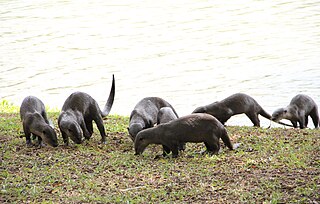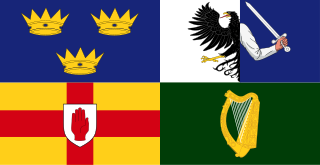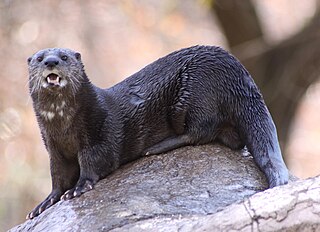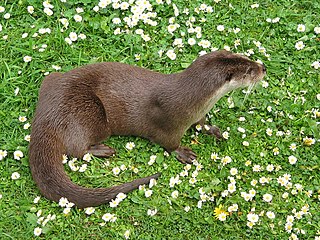 W
WOtters are carnivorous mammals in the subfamily Lutrinae. The 13 extant otter species are all semiaquatic, aquatic or marine, with diets based on fish and invertebrates. Lutrinae is a branch of the Mustelidae family, which also includes weasels, badgers, mink, and wolverines, among other animals.
 W
WThe African clawless otter, also known as the Cape clawless otter or groot otter, is the second-largest freshwater species of otter. African clawless otters are found near permanent bodies of water in savannah and lowland forest areas. They range through most of sub-Saharan Africa, except for the Congo River basin and arid areas. They are characterized by partly webbed and clawless feet, from which their name is derived. The word aonyx means "clawless", derived from the prefix a- ("without") and onyx ("claw/hoof").
 W
WAonyx is a genus of otters, containing three species, the African clawless otter, the Congo clawless otter, and the Asian small-clawed otter. The word aonyx means "clawless", derived from the prefix a- ("without") and onyx ("claw/hoof").
 W
WThe Asian small-clawed otter, also known as the oriental small-clawed otter or simply small-clawed otter, is a semiaquatic mammal native to South and Southeast Asia. This species is a member of the otter subfamily (Lutrinae) of the weasel family (Mustelidae), and is the smallest otter species in the world. Its paws are a distinctive feature; its claws do not extend beyond the fleshy end pads of its partially webbed fingers and toes. This gives it a high degree of manual dexterity so that it can use its paws to feed on molluscs, crabs and other small aquatic animals.
 W
WThe Bishan Otter Family, also known as the Bishan 10 and previously known as the Bishan 5, is a family of smooth-coated otters that reside in Singapore. The otters have become a popular local and international attraction since they were first spotted in 2014.
 W
WThe Congo clawless otter, also known as the Cameroon clawless otter, is a species of clawless otter in the family Mustelidae. It was formerly recognised as a subspecies of the African clawless otter.
 W
WThe Dobhar-chú or King Otter is a creature of Irish folklore. It resembles both a dog and an otter, though it sometimes is described as half dog, half fish. It lives in water and has fur with protective properties.
 W
WThe sea otter is a marine mammal native to the coasts of the northern and eastern North Pacific Ocean. Adult sea otters typically weigh between 14 and 45 kg, making them the heaviest members of the weasel family, but among the smallest marine mammals. Unlike most marine mammals, the sea otter's primary form of insulation is an exceptionally thick coat of fur, the densest in the animal kingdom. Although it can walk on land, the sea otter is capable of living exclusively in the ocean.
 W
WEnhydriodon was a genus of otters that lived in what is now Ethiopia during the Miocene and Pliocene epoch. The otter is thought to be a relative of modern-day otters. Enhydriodon was described as a considerably large otter, though only its skull has been found. Estimates put it at about 200 kilograms (440 lb), making it the largest mustelid described so far.
 W
WThe Eurasian otter, also known as the European otter, Eurasian river otter, common otter, and Old World otter, is a semiaquatic mammal native to Eurasia. The most widely distributed member of the otter subfamily (Lutrinae) of the weasel family (Mustelidae), it is found in the waterways and coasts of Europe, many parts of Asia, and parts of northern Africa. The Eurasian otter has a diet mainly of fish, and is strongly territorial. It is endangered in some parts of its range, but is recovering in others.
 W
WThe giant otter or giant river otter (Pteronura brasiliensis) is a South American carnivorous mammal. It is the longest member of the weasel family, Mustelidae, a globally successful group of predators, reaching up to 1.7 metres (5.6 ft). Atypical of mustelids, the giant otter is a social species, with family groups typically supporting three to eight members. The groups are centered on a dominant breeding pair and are extremely cohesive and cooperative. Although generally peaceful, the species is territorial, and aggression has been observed between groups. The giant otter is diurnal, being active exclusively during daylight hours. It is the noisiest otter species, and distinct vocalizations have been documented that indicate alarm, aggression, and reassurance.
 W
WThe hairy-nosed otter is a semiaquatic mammal endemic to Southeast Asia and one of the rarest and least known otter species. It is threatened by loss of natural resources and poaching.
 W
WThe spotted-necked otter, or speckle-throated otter, is an otter native to sub-Saharan Africa.
 W
WThe Japanese river otter (Japanese: ニホンカワウソ is an extinct variety of otter formerly widespread in Japan. Dating back to the 1880s, it was even seen in Tokyo. The population suddenly shrank in the 1930s, and the mammal nearly vanished. Since then, it has only been spotted several times, in 1964 in the Seto Inland Sea, and in the Uwa Sea in 1972 and 1973. The last official sighting was in the southern part of Kōchi Prefecture in 1979, when it was photographed in the mouth of the Shinjo River in Susaki. It was subsequently classified as a "Critically Endangered" species on the Japanese Red List. On August 28, 2012, the Japanese river otter was officially declared extinct by the Ministry of the Environment. It is the official animal symbol of Ehime Prefecture. In February 2017, a wild otter was caught on camera on Tsushima Island, Nagasaki Prefecture. However, it is not known whether the observed otter was a Japanese river otter.
 W
WLontra is a genus of otters from the Americas.
 W
WLutra is a genus of otters, one of seven in the subfamily Lutrinae.
 W
WLutrogale was proposed as generic name by John Edward Gray in 1865 for otters with a convex forehead and nose, using the smooth-coated otter L. perspicillata as type species.
 W
WMegalenhydris barbaricina is a Late Pleistocene giant otter from Sardinia. It is known from a single skeleton, discovered in the Grotta di Ispinigoli near Dorgali, and was described in 1987. The species is one of four extinct otter species from Sardinia. The others are Algarolutra majori, Cyrnolutra castiglionis and Sardolutra ichnusae. This otter was large, much larger than the other species. The structure of the teeth points to a diet of shellfish and/or crustaceans. A special characteristic of the species is the flattening of the first few caudal vertebrae. This might point to a slightly flattened tail.
 W
WOtter fishing is a fishing technique which uses trained otters to fish in rivers. This method has been practised since the 6th century in various parts of the world, and is still practiced in southern Bangladesh.
 W
WThe giant otter or giant river otter (Pteronura brasiliensis) is a South American carnivorous mammal. It is the longest member of the weasel family, Mustelidae, a globally successful group of predators, reaching up to 1.7 metres (5.6 ft). Atypical of mustelids, the giant otter is a social species, with family groups typically supporting three to eight members. The groups are centered on a dominant breeding pair and are extremely cohesive and cooperative. Although generally peaceful, the species is territorial, and aggression has been observed between groups. The giant otter is diurnal, being active exclusively during daylight hours. It is the noisiest otter species, and distinct vocalizations have been documented that indicate alarm, aggression, and reassurance.
 W
WSardolutra ichnusae is an extinct species of otter from the late Pleistocene of Sardinia. It was originally described as Nesolutra ichnusae. It was a rather small species of otter, probably living in the sea. Among its characteristics is a relatively very large baculum, larger than in any living otter. The species probably evolved from a species of Lutra, maybe L. castiglionis.
 W
WOtters are carnivorous mammals in the subfamily Lutrinae. The 13 extant otter species are all semiaquatic, aquatic or marine, with diets based on fish and invertebrates. Lutrinae is a branch of the Mustelidae family, which also includes weasels, badgers, mink, and wolverines, among other animals.
 W
WThe sea otter is a marine mammal native to the coasts of the northern and eastern North Pacific Ocean. Adult sea otters typically weigh between 14 and 45 kg, making them the heaviest members of the weasel family, but among the smallest marine mammals. Unlike most marine mammals, the sea otter's primary form of insulation is an exceptionally thick coat of fur, the densest in the animal kingdom. Although it can walk on land, the sea otter is capable of living exclusively in the ocean.
 W
WModern efforts in sea otter conservation began in the early 20th century, when the sea otter was nearly extinct due to large-scale commercial hunting. The sea otter was once abundant in a wide arc across the North Pacific ocean, from northern Japan to Alaska to Mexico. By 1911, hunting for the animal's luxurious fur had reduced the sea otter population to fewer than 2000 individuals in the most remote and inaccessible parts of its range.
 W
WThe smooth-coated otter is an otter species occurring in most of the Indian subcontinent and Southeast Asia, with a disjunct population in Iraq. It is listed as Vulnerable on the IUCN Red List since 1996 and is threatened by habitat loss, pollution of wetlands and poaching for the illegal wildlife trade. As its name indicates, its fur is smooth and shorter than that of other otter species.
 W
WThe spotted-necked otter, or speckle-throated otter, is an otter native to sub-Saharan Africa.
 W
WThe sea otter, Enhydra lutris, is a member of the Mustelidae that is fully aquatic. Sea otters are the smallest of the marine mammals, but they are also the most dexterous. Sea otters are known for their ability to use stones as anvils or hammers to facilitate access to hard-to-reach prey items. There are three recognized subspecies of otters, all of which exhibit tool use behavior in some capacity. Tool use behavior is more associated with geographic location than sub-species. Most behavioral research has been conducted on Enhydra lutris nereis, the Californian otter, and some has been conducted on Enhydra lutris kenyoni, the Alaska sea otter. Sea otters frequently use rocks as anvils to crack open prey, and they are also observed to rip open prey with their forepaws. While lying on their backs, otters will rip apart coral algae to find food among the debris. The frequency of tool use varies greatly between geographic regions and individual otters. Regardless of the frequency, the use of tools is present in the behavioral repertoire of sea otters and is performed when most appropriate to the situation.